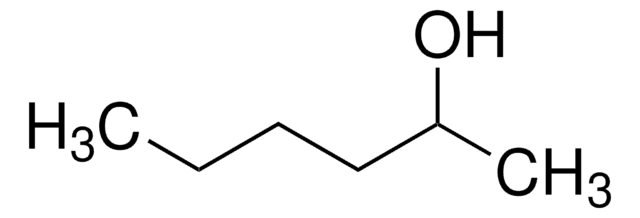H13303
1-Hexanol
reagent grade, 98%
Synonym(e):
Hexylalkohol
About This Item
Empfohlene Produkte
Qualität
reagent grade
Qualitätsniveau
Dampfdichte
4.5 (vs air)
Dampfdruck
1 mmHg ( 25.6 °C)
Assay
98%
Form
liquid
Selbstzündungstemp.
559 °F
Expl.-Gr.
0.34-6.3 %
Brechungsindex
n20/D 1.418 (lit.)
bp
156-157 °C (lit.)
mp (Schmelzpunkt)
−52 °C (lit.)
Dichte
0.814 g/mL at 25 °C (lit.)
SMILES String
CCCCCCO
InChI
1S/C6H14O/c1-2-3-4-5-6-7/h7H,2-6H2,1H3
InChIKey
ZSIAUFGUXNUGDI-UHFFFAOYSA-N
Suchen Sie nach ähnlichen Produkten? Aufrufen Leitfaden zum Produktvergleich
Verwandte Kategorien
Allgemeine Beschreibung
Anwendung
- Als Ölphase bei der Herstellung von Mangane-Zink-Ferrit-Nanopartikeln durch Ausfällung in einem Umkehr-Mikroemulsion-System.
- Als Lösungsmittel bei der Trennung von Carbonsäuren und Tetrahydrofurfurylalkohol von Wasser.
- Als Lösungsmittel bei der Synthese von ZnO(Zinkoxid)-Quantenteilchen aus Zinkacetat durch ein Ausfällungsverfahren.
Leistungsmerkmale und Vorteile
Signalwort
Warning
H-Sätze
Gefahreneinstufungen
Acute Tox. 4 Dermal - Acute Tox. 4 Oral - Eye Irrit. 2 - Flam. Liq. 3
Lagerklassenschlüssel
3 - Flammable liquids
WGK
WGK 1
Flammpunkt (°F)
140.0 °F - closed cup
Flammpunkt (°C)
60 °C - closed cup
Analysenzertifikate (COA)
Suchen Sie nach Analysenzertifikate (COA), indem Sie die Lot-/Chargennummer des Produkts eingeben. Lot- und Chargennummern sind auf dem Produktetikett hinter den Wörtern ‘Lot’ oder ‘Batch’ (Lot oder Charge) zu finden.
Besitzen Sie dieses Produkt bereits?
In der Dokumentenbibliothek finden Sie die Dokumentation zu den Produkten, die Sie kürzlich erworben haben.
Unser Team von Wissenschaftlern verfügt über Erfahrung in allen Forschungsbereichen einschließlich Life Science, Materialwissenschaften, chemischer Synthese, Chromatographie, Analytik und vielen mehr..
Setzen Sie sich mit dem technischen Dienst in Verbindung.






